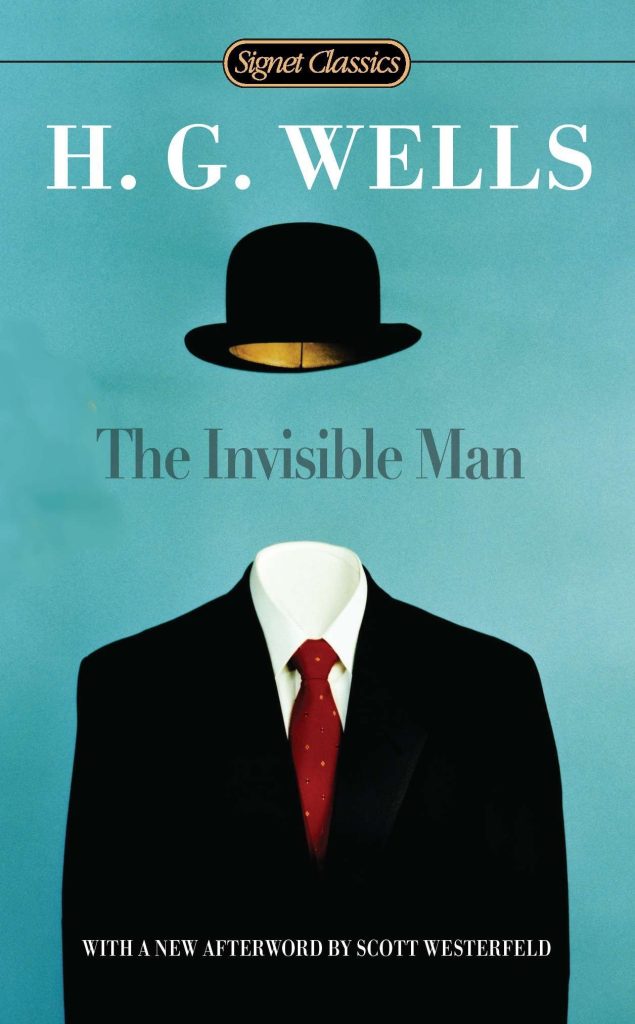We at Frankford Publishing love books. So we spent some time developing a top sci-fi book list over the pandemic. Who are we to be this presumptuous? No one, that’s who. Primarily, we were just bored: the top 20.
The plan is to review every entry in full. But before we get to that, let’s talk about a book that didn’t make the top 20, a so-called classic “The Invisible Man” by H.G. Wells.
Published in 1897, the premise is admittedly original. What would human society look like if a person couldn’t be seen? For old Herbert George, the answer was doing any damn thing one pleased. Such a scientist could steal shillings and pence, push people around, and generally maraud around the English countryside without consequence.

Well, there are some consequences. It’s winter, and invisibility only really works when one is naked. How scandalous and cold. In an unpaved world, footprints remain a problem, and rain causes a glitchy Predator effect. There’s probably a lesson about not being able to outrun oneself in there. H.G. Wells is at his best with these “plot metaphors,” but they are also confusing taken at face value.
The Invisible Man is only comfortable wrapped up like a mummy or in a privately rented room with a roaring fireplace. Most of the Invisible Man’s problems stem from the fact that he’s on the run and people are so nosy. For all their propers, no one had heard of a Do Not Disturb sign in the Victorian age.
Initially, the reader roots for the invisible man to fix himself, using whatever questionable alchemy got him there in the first place. But he keeps doing terrible deeds (done dirt cheap). He’s not really trying to save himself, he’s kind of a bully.
Using the parlance of roleplaying, humans who try to make themselves invisible trend toward Chaotic Evil. This is probably a sound judgment in philosophical terms. It’s reasonably Biblical. But as a work of fiction, it leaves the reader without a hero for which to root. The reader gets the sense it’s not going to go well for the Invisible Man, which makes this more of a Horror read than straight-up Science Fiction.
The Invisible Man’s eaten food is visible, which raises all sorts of disgusting questions about digestion and visibility. As a rule of thumb, the less I know about the bowels of the characters, the better. But it takes all types in this world.
There’s a humorous moment when, after IM goes ham in a remote village, the newspapers report it as “Small Town Loses Mind.” There’s something very prescient about misinformation and gaslighting in there.
But ultimately, like this review, the Invisible Man becomes a quest for justice. When (spoiler alert) the title character finally dies and becomes visible, he’s revealed to be an Albino. Gosh, is that even a word we can use anymore? Melaninly challenged is probably the preferred nomenclature. I’m not sure what Wells was trying to say with his lengthy descriptions of how evil and pale this dude was. The mind can come up with creative interpretations.
And, of course, this reviewer would be remiss not to point out Wells’ one regrettable usage of the N-word. We will never really know why he thought that was okay, even in 1897. Strictly in terms of plot construction or character building, none of this talk of skin tone was really necessary. He’s the Invisible Man. One benefit of writing the story of the Invisible Man would be the freedom to leave that conversation behind.
Some say modern readers shouldn’t judge the past by present standards, but it can be done. In Brave New World, Aldous Huxley passed the Bechdel test in 1932. It requires a writer who is not a raging meanie. It’s not tough to ask old Herbert George to spare us the commentary.
So, yeah. It was an interesting read, certainly groundbreaking. The underlying idea has gotten resampled a thousand times since it came out. But in the end, The Invisible Man had certain fatal flaws that it cannot overcome.
VERDICT: Do Not Recommend, two invisible thumbs down.